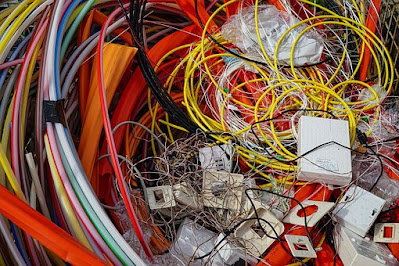Electronic Waste
Electronic Waste
Electronic waste, also known as e-waste, is a growing environmental problem that arises from the disposal of electronic devices that have reached the end of their useful life. These devices, such as computers, smartphones, televisions, and other electronic gadgets, contain toxic substances and hazardous materials that pose a significant threat to the environment and human health. According to the United Nations University, the world generated 53.6 million metric tons of e-waste in 2019, and this number is projected to reach 74.7 million metric tons by 2030.
The rapid growth of technology and the increasing demand for electronic devices have led to the proliferation of e-waste globally. Many electronic products are designed to have a limited lifespan, encouraging consumers to replace them frequently, resulting in a significant amount of electronic waste. In addition, the production of electronic devices requires the mining of precious metals and other raw materials, which results in environmental degradation and depletion of natural resources.
E-waste contains various hazardous substances, including lead, mercury, cadmium, and flame retardants, which pose a significant risk to the environment and human health. These toxic substances can leak into the soil and water, contaminating the environment and endangering the health of humans and wildlife. The toxic fumes released during the incineration of e-waste can cause respiratory problems and other health issues.
The improper disposal of e-waste is a significant contributor to environmental pollution. Many electronic devices end up in landfills, where they can take hundreds of years to decompose. As they decompose, the toxic substances they contain can seep into the soil and water, contaminating the environment and endangering the health of living organisms. Moreover, the incineration of e-waste releases toxic fumes into the atmosphere, contributing to air pollution.
To address the growing problem of e-waste, many countries have implemented regulations to manage the disposal of electronic devices. The European Union, for example, has implemented the Waste Electrical and Electronic Equipment (WEEE) directive, which requires producers to collect and dispose of e-waste in an environmentally responsible manner. The United States has also implemented regulations to manage the disposal of electronic devices, including the Resource Conservation and Recovery Act (RCRA).
The Indian government has taken several steps to prevent electronic waste, also known as e-waste. Here are some of them:
E-Waste Management Rules:
In 2016, the Indian government introduced the E-Waste Management Rules, which aim to regulate the generation, handling, and disposal of e-waste in an environmentally friendly manner. These rules require manufacturers to collect and dispose of their e-waste responsibly and also establish e-waste recycling facilities in the country.
Extended Producer Responsibility:
Under the E-Waste Management Rules, manufacturers are responsible for the disposal of their products once they become waste. This policy is known as Extended Producer Responsibility (EPR). The Indian government has made it mandatory for producers to implement EPR and to take back their products at the end of their life cycle.
Green E-Certificates:
The Ministry of Environment, Forests and Climate Change has launched a Green E-Certificate program, which aims to encourage recycling of e-waste. The program provides incentives to companies that use recycled e-waste in their manufacturing processes.
Awareness Campaigns:
The Indian government has launched several awareness campaigns to educate the public on the importance of responsible e-waste disposal. These campaigns aim to encourage individuals to recycle their old electronics instead of throwing them away.
E-Waste Management Fund:
The Indian government has set up an E-Waste Management Fund to support research and development of e-waste management technologies. This fund also supports the establishment of e-waste recycling facilities across the country.
These steps taken by the Indian government demonstrate a commitment to preventing e-waste and promoting responsible e-waste management practices. However, there is still much work to be done in this area, particularly in terms of enforcement of regulations and improving the infrastructure for e-waste recycling.
In addition to regulatory measures, there are several initiatives aimed at reducing the amount of e-waste generated globally. These initiatives include the development of sustainable design practices, the promotion of recycling and reuse, and the implementation of extended producer responsibility (EPR) programs. EPR programs hold manufacturers responsible for the entire lifecycle of their products, from production to disposal, and incentivize them to design products that are more environmentally friendly and easier to recycle.
Recycling and refurbishing electronic devices can also help reduce the amount of e-waste generated globally. By recycling electronic devices, precious metals and other valuable materials can be recovered and reused, reducing the need for mining and preserving natural resources. Refurbishing electronic devices can also extend their lifespan, reducing the need for new devices and the resulting e-waste.
In conclusion, electronic waste is a growing environmental problem that poses significant risks to the environment and human health. To address this issue, it is essential to implement regulatory measures and initiatives aimed at reducing the amount of e-waste generated globally. Recycling and refurbishing electronic devices can also help reduce the amount of e-waste generated and preserve natural resources. By taking action to manage e-waste, we can create a more sustainable future and protect the environment for generations to come.
Jay Hind




.jpg)

Comments
Post a Comment